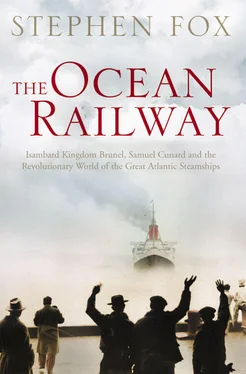The overall dimensions of her wooden hull, 236 feet long and 35 feet wide, didn’t make her look much different from other large ships of the day. ‘ Her size, when seen by herself, does not appear so great as it really is,’ one visitor noticed, ‘and it is only when on board, or seen alongside other vessels, whose size is known, that her magnitude is appreciated.’ The black-painted hull of the Great Western presented a flaring clipper bow with a figurehead of Neptune holding a gilded trident. The deck was dominated by four low masts, one looming black smokestack, and two elevated bridges that linked the paddle boxes. A double wheel on a circular platform at the stern allowed two (or more) sailors to muscle her rudder and steer the vessel. Three structures on the deck enclosed a forecabin 46 feet long, the top of the engine room at midship, and the 75-foot main saloon at the rear, the showplace of the ship.
The saloon offered a seagoing opulence and high-ceilinged airiness matched, at the time, only by Edward Knight Collins’s Dramatic Line of American sailing packets. The ornamental work was contracted out to Frederick Crace of Wigmore Street and the Messrs Jackson of Rathbone Place, two noted London decorating firms. In early Victorian style, they festooned the saloon with columns that imitated palm trees and large pier glasses that suggested Dresden china, and they painted the walls and ceiling in warm, delicate colours with gold highlights. Edward Thomas Parris, the historical painter to the queen, contributed door panels five feet high that presented vignettes across a carnival of cultures: rural scenery and farming, music, interior views and landscapes, sports and amusements, and the arts and sciences, all in the rococo manner of Louis XV. The main staircase, to the cabins below, had a bronzed and gilded ornamental railing, with woodwork painted in imitation oak. The small cabins accommodated up to 128 passengers and twenty servants. Regardless of brunel’s relative share in her creation, the Great Western had emerged as a recognizable brunel product: made of the finest materials and newest engineering, extravagant and original, truly the Great Western Railway at sea. (One impressed observer inevitably called her a ‘ floating palace’.)
Engined and finished in London, on 31 March she left Blackwall for Bristol, whence she would embark on her maiden voyage to New York. She steamed in large majesty down the Thames to the English Channel, the engine pumping easily with contained power, black coal smoke pouring from the stack. brunel and Claxton were aboard, watching and approving. Everything seemed in fine order on this shakedown cruise – until a serious firebroke out in the engine room. The felt insulation around the boilers, installed to improve steam efficiencies and keep the room temperature tolerable for the stokers, had ignited from the heat of the pipes, and the fire was quickly spread by oil paint and gas to the wooden beams and deck overhead. The flames licked as high as the top of the smokestack, holding back attempts to reach into the engine room. Claxton took a leather hose down to the fore-hatch and from there poured water on the fire. brunel started down to help him, lost his footing on the burned rung of a ladder, fell heavily on top of Claxton, and lay unconscious, facedown in a puddle of water. (It recalled his accident in the Thames Tunnel ten years earlier: nearly killed by his own engineering project.) Claxton saved his life by breaking his fall, pulling him out of the puddle, and calling for a rope. brunel was hauled up on deck, suffering from a dislocated shoulder and a broken leg.
The fire burned on. The commander, Lieutenant James Hosken of the Royal Navy, thought about running out the lifeboats and taking off passengers, but he instead beached the Great Western on a flat riverbank, where she sat upright on her bottom. Men finally broke through the deck into the engine room and put out the flames. Refloated on the next high tide, surprisingly undamaged except for the burned felt and some charred wood, the ship proceeded to Bristol. After three days, brunel felt well enough to dictate a long letter to Claxton about the generally satisfactory performance of the ship and her engine, hardly mentioning his injuries. ‘ I hope the Vesselwill be a long way on her Voyage to New York,’ he wrote, ‘before I could be in a state to go onboard again.’
The fire must have pleased Junius Smith. Nursing an exalted opinion of his own historical significance, he liked to call himself ‘ the father of Atlantic steamnavigation’. Smith believed that he alone owned the very concept of a transatlantic steamship. He had started his company before the Bristol group got under way, and now, with the long-delayed British Queen not even launched yet, he could not bear in frustration and defeat to let the Great Western beat him across the ocean. So Smith and Macgregor Laird chartered the Sirius, a well-regarded channel steamer of only 700 tons, loaded her down with fuel, and sent her on a risky, shortened passage to New York from Cork, on the southern coast of Ireland. (Starting from Cork knocked a day’s sailing off the course to America from Bristol.) The voyage of the Sirius was just a heedless, dangerous publicity stunt, a desperate gambit by sore losers, and hardly worth the historical attention it has received ever since.
The Great Western left Bristol for New York as scheduled on 8 April, four days behind the Sirius. The first Atlantic steamship race, contrived and unequal, was under way. brunel had provided Hosken with an engraved Mercator-projection chart of his great circle route, marked with bearings and soundings, to help keep the ship on the fastest course. The Great Western carried only seven passengers at thirty-five guineas (about thirty-seven pounds) apiece; fifty additional passengers had intended to go but were scared away by the fire. These seven brave pioneers in transatlantic steaming were amply serviced by fifty-seven crew members, including twenty-four seamen above deck and fifteen sweating coal stokers below. During the entire voyage, the engine was only stopped three times, briefly, for minor adjustments and to take soundings on the Newfoundland Banks. That meant little rest for the stokers. They struggled to bring coal by basket and wheelbarrow from holds at the bow and stern, where the ship’s pitching and rolling motions were exaggerated. The stokers complained; Captain Hosken warned them to obey the chief engineer. Without enough coal, the boilers were barely maintaining adequate steam pressure. The stokers were pushed harder and promised extra pay. One exhausted stoker named Crooks got drunk and unruly, which inspired him to try to throw the captain overboard. For this egregious lapse of discipline, Crooks was restrained and tied up. The other stokers stopped working until he was released: not a near-mutiny by real sailors but a hint of proletarian industrial unrest transferred from land to the unfamiliar regimen of a seaborne boiler room.
Up on deck, the more experienced passengers noticed differencesfrom life on a sailing packet. Morning conversations brought fewer fretful speculations about the wind and weather; the wind hardly mattered now. Instead the novel, somewhat frightening steam engine dominated everything on board. Nobody had ever crossed the ocean in the relentless presence of so audible, tangible a machine. All day and night it hissed and clanked, smoked and steamed, heating the deck from below so that tar bubbled up between the seams, sticky and persistent. The smoke and smuts blew around unpredictably, blackening clothes and alighting on hair. The engine lubricants, derived from animal fats with low combustion points, burned and smelled pervasively like a constant, enormous kitchen fire, a bilious irritant to anyone fighting seasickness or confined to a cabin below. The sea atmosphere, usually clean and bracing, felt cooked and greasy. Some people worried about being blown up by the overworked boilers or getting suddenly forced out of bed with no time to get dressed.
Читать дальше












